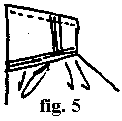 The Byrrus
A Roman Provincial Overgarment
Among the sagum and paenula of the Roman provinces, there also existed an overcoat-like garment of Gallish origin called the byrrus or birrus. It consisted of s semicircular cape with sleeves and sometimes a hood which resembling the cotegard of the 14th Century. The semicircular fabric for the byrrus was shaped on the loom or made in segments which were later stitched together. The best byrri were made by the Nervii around Bavai (near Charleroi in modern Belgium), and Cost 10,000 denarii. Cheaper versions were produced in Britain, Dacia, Noricum and Malta. One version made in North Africa was the cheapest of all at 3000 denarii. The byrrus bears a remarkable resemblance to the brynous or burnoose of northern Africa. I suspect it may be derived from the Roman period garment.
You will need approximately 3 yards of material for an average sized person.
The Byrrus
A Roman Provincial Overgarment
Among the sagum and paenula of the Roman provinces, there also existed an overcoat-like garment of Gallish origin called the byrrus or birrus. It consisted of s semicircular cape with sleeves and sometimes a hood which resembling the cotegard of the 14th Century. The semicircular fabric for the byrrus was shaped on the loom or made in segments which were later stitched together. The best byrri were made by the Nervii around Bavai (near Charleroi in modern Belgium), and Cost 10,000 denarii. Cheaper versions were produced in Britain, Dacia, Noricum and Malta. One version made in North Africa was the cheapest of all at 3000 denarii. The byrrus bears a remarkable resemblance to the brynous or burnoose of northern Africa. I suspect it may be derived from the Roman period garment.
You will need approximately 3 yards of material for an average sized person.
To construct:
Follow the directions for cutting in Figure 1. Cut along the dotted lines. Do not cut out the flap at the neck opening. This forms the back of the hood.

 Match the sleeves and slanted cuts on the semicircular section. Leave ¾" unsewn at each side of the sleeve top, and follow the seam pattern shown in Figure 2. Slash the corners of the sleeve bottom seam. Figure 2A . Now sew the top of the sleeve together (Figure 2B). Repeat for the other side.
Sew the sections marked B to each side of the hood panel. (see Figure 3)
Match the sleeves and slanted cuts on the semicircular section. Leave ¾" unsewn at each side of the sleeve top, and follow the seam pattern shown in Figure 2. Slash the corners of the sleeve bottom seam. Figure 2A . Now sew the top of the sleeve together (Figure 2B). Repeat for the other side.
Sew the sections marked B to each side of the hood panel. (see Figure 3)
Sew the hood edges to the shoulder edges of the cloak, to the hood pieces. (Figure 4)
Sew the top of the hood together. (Figure 5)

 Finish the inside seams by folding under and stitching down. If the selvage on the front of the byrrus is not attractive, turn it under and stitch it down. You may also sew the front closed if you wish. Hem the semicircular edge by turning under and slipstitching down. Hem the sleeve edges.
Sources:
Finish the inside seams by folding under and stitching down. If the selvage on the front of the byrrus is not attractive, turn it under and stitch it down. You may also sew the front closed if you wish. Hem the semicircular edge by turning under and slipstitching down. Hem the sleeve edges.
Sources:










